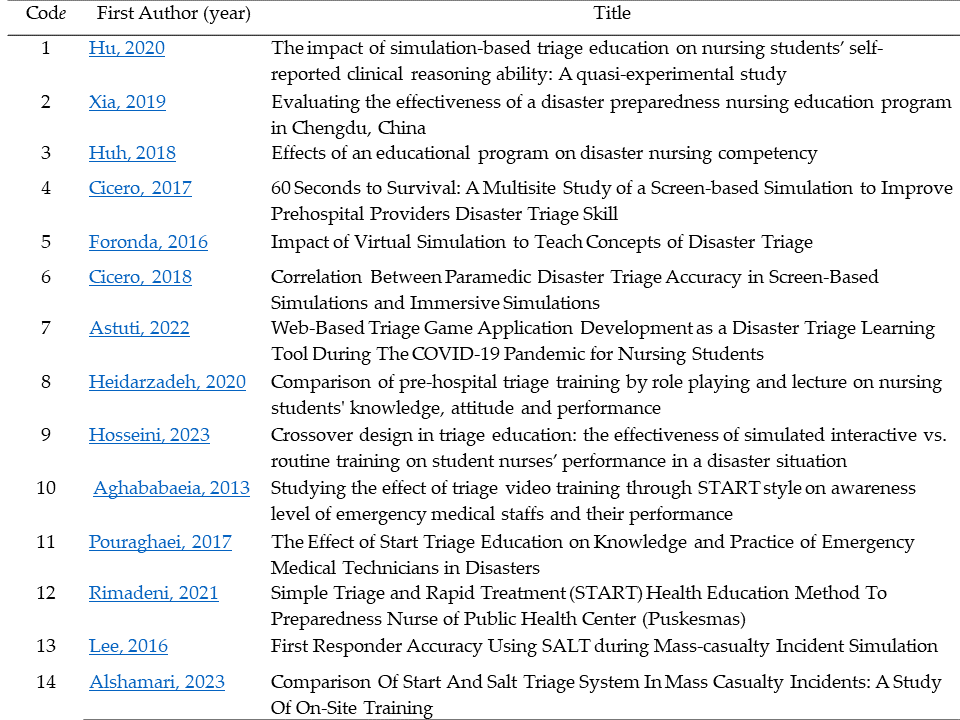An Education and Training Program on Disaster Triage for Nurses and Nursing Students: Literature Review
DOI:
https://doi.org/10.23917/bik.v17i1.3882Abstract
Natural disasters continue to increase globally yearly. Over 1.6 billion people live in disaster-prone areas, conflict zones, and displacement areas. The impacts of disasters highlight the importance of disaster preparedness to minimize errors in disaster triage management. However, nurses' knowledge and skills in implementing initial triage procedures are still adequate. This scooping review aims to find an overview of implementing disaster triage education and training programs. This research is a scooping review using the Prisma flow chart in its implementation. This study showed significant results in all articles (n = 14) in increasing knowledge, attitudes, skills, awareness, preparedness, accuracy, and learning motivation in conducting disaster triage. The methods used are simulation methods (live, virtual reality, and screen-based) and training and education methods (lectures, discussions, videos, roleplay, and games) with material on disaster triage, START triage, and SALT triage concepts. This study concluded that disaster triage education for nurses and nursing students is very important to be provided by carrying out the latest methods so that the results are more effective.
References
Aghababaeian, H., Taheri, N., Sedaghat, S., & Bahrami, N. (2013). Studying the effect of triage video training through START style on awareness level of emergency medical staffs and their performance. Iranian Journal of Critical Care Nursing, 6(3), 205–212. https://jccnursing.com/article-1-262-fa.pdf
Ainiyah, N., Ahsan, & Fathoni, M. (2015). Analisis faktor pelaksanaan triage di Instalasi Gawat Darurat. Jurnal Ners, 10(1), 147–157. https://doi.org/ 10.20473/jn.V10I12015.147-157
Alshamari, N. G., Alenezi, S. Z., Mzahim, B., Nafisah, S., Alomari, H., Ateeq Alateeq, M., & Mohammed Aldobeaban, S. (2023). Comparison of Start and Salt Triage System in Mass Casualty Incidents: a Study of on-Site Training. International Journal of Advanced Research, 11(06), 482–489. https://doi.org/10.21474/ijar01/17092
Anwar, K. (2021). Peran Profesi Perawat Dalam Penanggulangan Bencana Di Indonesia. 5(2), 46–56. https://doi.org/10.21009/EIPS.005.2.06
Astuti, Z., Milkhatun, M., & Latipah, A. J. (2022). Web-Based Triage Game Application Development as A Disaster Triage Learning Tools During The Covid-19 Pandemic for Nursing Students. Indonesian Nursing Journal of Education and Clinic (Injec), 7(1), 53. https://doi.org/10.24990/injec.v7i1.452
Bijani, M., & Khaleghi, A. A. (2019). Challenges and Barriers Affecting the Quality of Triage in Emergency Departments: A Qualitative Study. Galen Medical Journal, 8. https://doi.org/10.31661/gmj.v8i0.1619
Cicero, M. X., Whitfill, T., Walsh, B., Diaz, M. C., Arteaga, G., Scherzer, D. J., Goldberg, S., Madhok, M., Bowen, A., Paesano, G., Redlener, M., Munjal, K., Kessler, D., & Auerbach, M. (2018a). 60 Seconds to Survival: A Multisite Study of a Screen-based Simulation to Improve Prehospital Providers Disaster Triage Skills. AEM Education and Training, 2(2), 100–106. https://doi.org/10.1002/aet2.10080
Cicero, M. X., Whitfill, T., Walsh, B., Diaz, M. C. G., Arteaga, G. M., Scherzer, D. J., Goldberg, S. A., Madhok, M., Bowen, A., Paesano, G., Redlener, M., Munjal, K., & Auerbach, M. (2018b). Correlation Between Paramedic Disaster Triage Accuracy in Screen-Based Simulations and Immersive Simulations. Prehospital Emergency Care, 23(1), 83–89. https://doi.org/10.1080/10903127.2018.1475530
Connor, E. O., Gatien, M., Weir, C., & Calder, L. (2014). Evaluating the effect of emergency department crowding on triage destination. International Journal of Emergency Medicine, 7(16), 1–7. https://doi.org/10.1186/1865-1380-7-16
Dorasamy, M., Raman, M., & Kaliannan, M. (2020). Knowledge management systems in support of disasters management: A two decade review Magiswary. Technological Forecasting & Social Change Knowledge, 80(2013), 1834–1853. https://doi.org/http://dx.doi.org/10.1016/j.techfore.2012.12.008
Eryilmaz, Durusu, Topuzlar, Baykal, Mentes, & Oner. (2017). START Triage Exercise at the Gulhane Military Medical Academy. April, 1049023. https://doi.org/https://doi.org/10.1017/S1049023 X00060052
Foronda, C. L., Shubeck, K., Swoboda, S. M., Hudson, K. W., Budhathoki, C., Sullivan, N., & Hu, X. (2016). Impact of Virtual Simulation to Teach Concepts of Disaster Triage. Clinical Simulation in Nursing, 12(4), 137–144. https://doi.org/10.1016/j.ecns.2016.02.004
Heidarzadeh, H., Heidarzadeh, Z., & Azadi, A. (2020). Comparison of pre-hospital triage training by role playing and lecture on nursing students’ knowledge, attitude and performance. Nursing Open, 7(4), 935–942. https://doi.org/10.1002/nop2.464
Hosseini, M. M., Hosseini, S. T. M., Qayumi, K., Hosseinzadeh, S., & Ahmady, S. (2023). Crossover design in triage education: the effectiveness of simulated interactive vs. routine training on student nurses’ performance in a disaster situation. BMC Research Notes, 16(1), 1–13. https://doi.org/10.1186/s13104-023-06596-5
Hu, F., Yang, J., Yang, B. X., Zhang, F.-J., Yu, S.-H., Liu, Q., Wang, A.-L., Luo, D., Zhu, X.-P., & Chen, J. (2021). The impact of simulation-based triage education on nursing students’ self-reported clinical reasoning ability: A quasi-experimental study. Nurse Education in Practice, 50, 102949. https://doi.org/https://doi.org/10.1016/j.nepr.2020.102949
Huh, S. S., & Kang, H. Y. (2018). Effects of an educational program on disaster nursing competency. Public Health Nursing, 36(1), 28–35. https://doi.org/10.1111/phn.12557
Hung, M. S. Y., Lam, S. K. K., & Chow, M. C. M. (2020). Nursing students’ experiences and perceptions of learner-centred education in a disaster nursing course: A qualitative study. Nurse Education in Practice, 47. https://doi.org/10.1016/j.nepr.2020.102829
Lee, C. W. C., Mcleod, S. L., Van Aarsen, K., Klingel, M., Franc, J. M., & Peddle, M. B. (2016). First responder accuracy using SALT during mass-casualty incident simulation. Prehospital and Disaster Medicine, 31(2), 150–154. https://doi.org/10.1017/S1049023X16000091
Lumbu, R. S., Niswar, M., & Baharuddin, M. (2013). Management Information System for Coping With Disaster Victim. Repository UNHAS, 13. http://repository.unhas.ac.id/id/eprint/10865/4/robystevil-2728-1-13-roby-%291-2.pdf
Mace, Sharon E and Mayer, Thom A. (2013). Triage. Chapter 15. Section IV. The Practice Environment.
OHCA. (2022). Global Natural Disaster Assessment Report. UN Annual Report, October, 1–80. https://reliefweb.int/report/world/2021-global-natural-disaster-assessment-report
Phukubye, T. A., Mbombi, M. O., & Mothiba, T. M. (2019). Knowledge and Practices of Triage Amongst Nurses Working in the Emergency Departments of Rural Hospitals in Limpopo Province. The Open Public Health Journal, 12(1), 439–448. https://doi.org/10.2174/1874944501912010439
Pouraghaei, M., Sadegh Tabrizi, J., Moharamzadeh, P., Rajaei Ghafori, R., Rahmani, F., & Najafi Mirfakhraei, B. (2017). The Effect of Start Triage Education on Knowledge and Practice of Emergency Medical Technicians in Disasters. Journal of Caring Sciences, 6(2), 119–125. https://doi.org/10.15171/jcs.2017.012
Pranoto, Y. A., & Wibowo, S. A. (2020). Aplikasi Desktop Sistem Triase Untuk Pendukung Prioritas Tingkat Kegawatan. Jurnal Mnemonic, 3(1), 1–6. https://doi.org/10.36040/mnemonic.v3i1.2319
Rimadeni, Y., Munazar, Arnisam, & Yeni, M. (2021). Simple Triage and Rapid Treatment (START) Health Education Method To Preparedness Nurse of Public Health Center (Puskesmas). Journal of Scientific Information and Edocational Creativity, 22(2), 224–235. https://ojs.serambimekkah.ac.id/serambi-ilmu/article/view/3310
Saragih, S. (2019). Pengetahuan Tim Search and Rescue (SAR) Tentang Triage Pre-Hospital Pada Korban Bencana Di Basarnas Medan Tahun 2019. http://repo.poltekkes-medan.ac.id/xmlui/handle/ 123456789/2127
Sumarno, M. S. S., Ismanto, A. Y., & Bataha, Y. (2017). Kepuasan Keluarga Pasien Di Instalasi Gawat Darurat. E-Jurnal Keperawatan, 5(1), 1–6. https://ejournal.unsrat.ac.id/index.php /jkp/article/viewFile/15896/15409
World Health Organization. (2019). Health Emergency and Disaster Risk Management Framework. In Health Organization (issue December). https://www.who.int/hac/ techguidance/preparedness/ health-emergency-and-disaster-risk-management-framework-eng.pd?ua=1
Xia, R., Li, S., Chen, B., Jin, Q., & Zhang, Z. (2019). Evaluating the effectiveness of a disaster preparedness nursing education program in Chengdu, China. Public Health Nursing, 37(2), 287–294. https://doi.org/10.1111/phn.12685

Downloads
Submitted
Accepted
Published
How to Cite
Issue
Section
License
Copyright (c) 2024 Novia Faizatiwahida, Sri Setiyarini, Syahirul Alim

This work is licensed under a Creative Commons Attribution 4.0 International License.


















